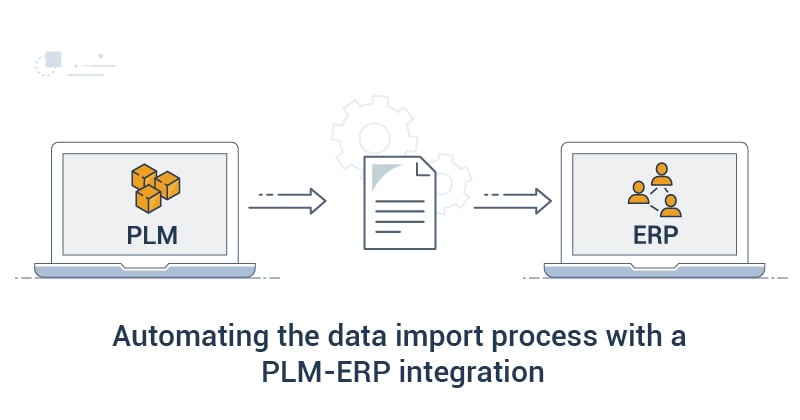PLM and ERP are two critical systems used by manufacturing companies around the globe to carry out different business processes. While they are traditionally separate systems, each having a specialized function, sharing information between them is essential to avoid losing critical data.
To close the gap between PLM and ERP, companies have resorted to a simple import-export process, which is manual and time-consuming.
We at To-Increase have over 17 years of experience integrating PLM systems with Microsoft Dynamics 365 ERP. During our interactions with manufacturing companies, we have often been asked: “How do I automate the data import and product release process from my PLM system to Dynamics 365 ERP?”
This article will offer the answer to the above question in the following sequence:
- What is a manual data import process from PLM to ERP?
- What are the challenges of relying on a manual import and product release process?
- How can you automate the data import and product release processes?
- How does PLM-ERP integration automate the entire import and release processes?
What does a manual data import process from PLM to ERP look like?
In an average manufacturing company, you are required to share certain data from the PLM to ERP. With a manual process, the engineering team or staff operating within the PLM system will export or extract data from the PLM system in a particular data format, such as Excel.
The data file is copied to another system and manually entered and updated into the ERP.
Whenever more data is sent out from the PLM to the ERP, the process of loading, transporting, and importing the data is repeated.
What are the challenges with a manual import and product release process?
Sharing your data from the PLM to ERP using a manual process causes several challenges. The top three issues it can pose for your company are:
1. Repeated and increased effort
- Items are to be created in D365 ERP separately, increasing the workload
- Product items are not engineering-controlled, making you double-check every piece of data loaded
- Create and add all item settings for each product in the D365 ERP
- Repeatedly check product data for errors or outdated information, which is tedious and inaccurate
- Changes or updates in items are to be done separately in the D365 ERP, increasing the effort
- BOM structures and master data items have to be redone in the D365 ERP system
2. Issues with product data
- Lack of data ownership between the PLM system and D365 ERP
- No assurance of the quality of data import, increasing the likelihood of incorrect data
- Duplication of data happens with no control over the data
- Loss of data occurs as certain data could be overlooked or forgotten in a manual process
3. Unreliable and slow process
- The time-consuming process causes downstream problems, leading to revenue loss
- There is a limited scope of data you can transfer due to ‘import volume’ issues
- Manual processes are slow, rely on people, and increase the chances of human error
- Product release processes are siloed, especially when dealing with multiple legal entities
How can you automate the data import and product release process from PLM to ERP?
You've seen how a manual process can cause multiple challenges with your product and data in your PLM and ERP systems, leaving you with information gaps and cumbersome processes. So, how can you automate the 'sharing of information' from PLM to ERP? A direct integration that connects the two systems is the solution.
There are several benefits of a PLM-ERP integration solution. It creates a seamless, fast, accurate, and direct connection from your PLM system to the D365 ERP. The integration solution eliminates the scope of human error, and you can send, create, and sync data automatically between the PLM and ERP systems. Additionally, there is no limit on the amount of data you can export, allowing you to communicate more comprehensively from the PLM to ERP.
A PLM-ERP integration automates all the processes around product data movement, such as:
1. Picking and dropping the data from PLM to D365
2. Ensuring data quality
3. Validating the product data
4. Managing product versioning
5. Releasing products to respective operational companies
6. Offering insights on products and product lifecycle
7. Handling product attributes
How does a PLM-ERP integration solution automate the data import process?
You know that a PLM-ERP integration is the solution to automate your data import and product release processes. But how does it work? Let’s look at how each of the processes mentioned above is automated.
1. Import and export of data
The PLM-ERP integration is embedded in Dynamics 365 for Finance and Supply Chain Management and leverages the batch server process in D365 (a common process in D365 for running invoices, master planning, foreign currency evaluation, processing payroll, and doing automated work).
You can use batch processing to automatically pick up and drop off data from the PLM to the D365 ERP. The integration, along with the Engineering Change Management (ECM) module within D365 F&SCM, automatically populates several components of each product by setting up defaults in the template, saving time and effort.
You can also set up periodic checks (for example, every hour) to monitor new data coming in from the PLM. The data is automatically imported into the staging journal.
2. Ensures quality of data
The integration solution ensures data quality by validating if the data is mapped correctly to Dynamics 365 ERP. Any product data exported from the PLM system is first validated, processed, and transformed before releasing it. This is done without the need for any manual interaction.
3. Validation of product data
The necessary validations or readiness checks are done using ECM. It approves the data, and the journal is posted with all the defaults. The product data is released only after these validations are done. Additionally, you are instantly notified if there’s an error in any product data.
4. Manages product versioning
The PLM-ERP integration solution recognizes changes within the PLM system's product versions or BOM lines. It automatically updates it in the ERP without changing other product fields, thereby maintaining data ownership.
Any change in the PLM, resulting in a second product version based on the change order, will be automatically updated in Dynamics 365 ERP. You have increased insight into version updates and better control of your information.
5. Release process of products
The ECM and the PLM integration together efficiently manage product releases. You can decide the amount of product data you want to release to different departments or companies you’re dealing with. With flexible release policies, you can do part releases, full releases, or release multiple active BOMs for one product by setting up the relevant routings.
6. Insights into the product lifecycle
Using the PLM-ERP integration solution, you can get insights into each product's lifecycle stage or status. This gives you information on how a user can use a particular product.
You know the product lifecycle status, such as obsolete, prototype, etc. Different teams can view all the changes made in the past to understand how the products have progressed, increasing productivity.
7. Handles product attributes
The PLM-ERP integration solution allows you to easily add additional data fields or attributes sent to the ERP with a simple configuration. You can get information about the product specifications, such as color, weight, height, and dimensions. Using the solution, you can integrate large data sets and adopt changes in the product data before importing them.
Here is a video demonstrating how our PLM-ERP integration for Dynamics 365 manages data ownership, automatically imports data from PLM to Dynamics 365 ERP, and posts the data.
Are you ready to automate your data import process with PLM-ERP integration?
The beauty of a PLM-ERP integration solution is that it is a one-time set-up, and you reap the benefits for a long time. Once the integration is up and running, you will have so many processes automated by default that the connection between your PLM and D365 F&SCM ERP will be smooth and seamless.
If you are interested in an intuitive, easy-to-use integration solution that automates all the above-discussed processes and more, you could explore our PLM-ERP integration.
We offer out-of-the-box PLM integrations for Siemens Teamcenter and PTC Windchill. Additionally, we provide PLM integrations with 3DX Dassault and a PLM integration framework that you can easily configure for other PLM, PDM, or CAD systems.
Check out our solution factsheet, which offers you insights into:
- What the integration solution can do for your business
- Benefits of PLM-ERP integration
- Features of a standard integration solution





